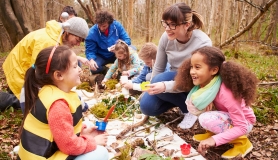Fresh air and exercise – wear everyone out and they’ll all sleep well. Myself included. So while ante/post-natal friends signed up for membership of the local soft play café – or the local children’s farm (soft play with animals on site), I went to the woods. I can pretend that this was for the dog’s benefit, but really it was for mine – and I also suspected early on that my big girl is not really a people person (she certainly has friends, but likes to do her socialising in moderation).
At first, walking the dog, I wore one child, then the other, in slings or structured backpacks. As time went on, they grew heavier – and multiplied, whilst I still only had one back. My doggo was young and sprightly – and not impressed by the distance travelled by a toddler. What incentives could I provide to make those little legs walk just a little further? Just at the point I was exploring this conundrum, nature provided an answer by filling the bushes and hedgerows with ripe sweet temptation: blackberries. Can you go just a little further? That bush over there looks like it might be good picking. Sticky fingers, purple tongues, stains on clothing – suddenly we had been out for hours. We might not have got a crumble out of it, but we were all rosy and exhausted – and that included the hairy boy, who also came home with a purple tongue, being very good at foraging the low branches.
Gradually, foraging became something we did normally and naturally outside. Early summer mornings when the children were awake at dawn, poking me torturously when I would have preferred to stay under the duvet for at least three more hours. Misty autumn days when sparkling droplets hung on the blackthorn. Warm afternoons late in the year, when wild raspberries came back into fruit after they should have finished. We were out, we were fed. Yes, I could take snack bars and say “We’ll stop when we get to the next stile” but how much more exciting to find something on the way. Being alerted to cobnuts by the crunching of shells underfoot, brought down by squirrels; realising they hung low in the trees in frilled green skirts. Wild summer strawberries emerging from crevices. Autumn sweet chestnuts taken home to roast. Discovering that some of our local footpaths are lined with cherries and plums – smaller and less sweet than the supermarket variety, but still bright spots lighting the way. Tart, red cherries, yellow plums. The aroma of fallen fruit fermenting on the ground. We could see them planted along the far edge of the car park of our local leisure centre, hanging heavy downwards. The birds knew and pecked at them, but all the people just walked past, not looking up - certainly not popping one in their mouths. Even in a bumper year, when they dropped over the ticket machines, no one saw. For the children, it was like seeing a secret code in the landscape.
There were a couple of people we knew who liked to do similar. My younger daughter was surprised to find a friend picking the very tops off young nettles in early spring and popping them in her mouth. I haven’t tried this myself, so cannot comment on the likelihood of stinging the tongue, but for the less bold there are many recipes for nettle soup, nettle tea and nettle beer available. I intend to try the brewing at some point, but remember my own mother’s attempts at fermentation blowing the tops off their bottles and foaming in the hedge, where she had stuck them to avoid the contents spraying over the kitchen.
We talked about how some berries must not be eaten – or not eaten raw. Rowan berries are poisonous uncooked, but can be used to make jelly. Sloes are uninspiring raw but may be used in jellies or puddings, although they do contain a toxin which may cause breathing difficulties in a minority of people. However, the true purpose of the sloe is, in my estimation, to be frozen so the skins split, then drowned in gin. (“Maybe when you’re older, girls…”) At a playgroup once, I mentioned blackberry picking to a father attending with similarly aged girls; his response was a look of horror as he told me that he told his children to touch nothing when they were outside, as they didn’t know what was dangerous. Not only did this feel extreme, it represented a sad severing of the relationship between humans and the natural world. I preferred to explain what they could and could not do safely.
To that end, we do not touch mushrooms. We always point out the mushrooms, the colours, the ways they grow attractively in groups – occasionally the amusingly shaped ones. The exciting names: the chicken-of-the-woods, the amethyst deceiver. We take only photos, however. I have been on fungi forays with mycologists and picked and eaten when advised to do so – but alone, I am not sufficiently confident in identification and leave everything on the ground. The things that are good to eat have a nasty tendency of looking just like a close relative which will make you ill.
As they have grown older, they have more patience for picking the things they cannot immediately eat. Sloes, I have mentioned, but also wild garlic, elderberries to be used in cooking, elderflowers to make cordial. Crab apples, which are beautifully coloured, but difficult to imagine as useful if you haven’t seen the jelly. I tell them how my grandfather picked seaweed off the rocks to cook up with potatoes and my great-grandfather flipped flat fish out of the estuary with his toes.
There are prickles and scratches, some encounters with creatures with more legs than us (not just the dog): they live here too. How beautiful the webs are, how intricate the structure. We never over-pick, remembering that birds and other animals need it more than us.
What started as dog exercise and soft play avoidance has evolved into broader discussions about the environment: car pollution, via not picking blackberries near the road; chemical use in food production; the prevalence of single-use plastics in packaging; the quantity of ‘wonky’ food wasted due to not meeting supermarket standards. It has made them aware of issues that may not have meant so much, if tackled without an emotional connection to the products of the land. It has made all of us more connected to the seasons, in an age when you can still buy tomatoes in December. And enjoying a shared task, without sitting down to look at each other, can be quite a good way to enjoy a frank conversation with a teenager. All of this – and jam too.
K R Reeve lives in Hertfordshire, where she is preparing two girls for release into the wild. Usually writes short fiction. Has a cupboard full of sloe gin. Likes being outdoors, dogs with beards and dead languages. Tries to remember to tweet at @K_R_Reeve







